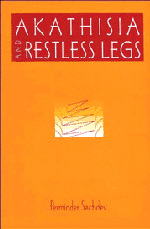Book contents
- Frontmatter
- Contents
- Foreword
- Acknowledgements
- Abbreviations
- Part I Introduction
- 1 Akathisia: development of the concept
- 2 The anatomy of restlessness
- 3 Neuroleptic-induced dysphoria
- Part II Drug-induced akathisia
- Part III Restless legs syndrome
- Part IV Conclusions
- Appendix A Haskovec's Akathisie
- Appendix B Prince Henry Hospital Akathisia Scale
- Appendix C Barnes (1989) Akathisia Rating Scale
- Appendix D Hillside Akathisia Scale (version 4)
- References
- Index
1 - Akathisia: development of the concept
from Part I - Introduction
Published online by Cambridge University Press: 12 September 2009
- Frontmatter
- Contents
- Foreword
- Acknowledgements
- Abbreviations
- Part I Introduction
- 1 Akathisia: development of the concept
- 2 The anatomy of restlessness
- 3 Neuroleptic-induced dysphoria
- Part II Drug-induced akathisia
- Part III Restless legs syndrome
- Part IV Conclusions
- Appendix A Haskovec's Akathisie
- Appendix B Prince Henry Hospital Akathisia Scale
- Appendix C Barnes (1989) Akathisia Rating Scale
- Appendix D Hillside Akathisia Scale (version 4)
- References
- Index
Summary
Akathisia, a stepchild of movement disorders and an orphan of psychiatry, is beginning to receive the serious attention and clarification it deserves.
Stephen Stahl (1985)The term akathisia is of Greek derivation and, translated literally into English, means ‘not to sit’. It was first used by Lad Haskovec (1902) (see Appendix A) to describe two patients with restlessness and an inability to sit still. Descriptions of a syndrome resembling akathisia can, however, be traced to much earlier than the beginning of the twentieth century. The first documented description has been attributed to the British physician and anatomist Thomas Willis (1621–1675), better known for his careful studies of the nervous system. The first edition of his London Practice of Physik was published in 1685, but Critchley (1955) quoted from his second edition, printed in 1695, as follows: ‘Wherefore to some, when being a Bed they betake themselves to sleep, presently in the Arms and Leggs, Leapings and Contractions of the Tendons, and so great a Restlessness and Tossings of their Members ensue, that the diseased are no more able to sleep, than if they were in a Place of the greatest Torture’ (p. 101).
The earliest nineteenth-century account resembling akathisia has been attributed to Wittmaack (1861), who referred to the syndrome as anxietas tibiarum and gave a one-page account of ‘die von den alteren Aerzten so genannte Anxietas tibiarum’ (p. 459).
- Type
- Chapter
- Information
- Akathisia and Restless Legs , pp. 3 - 17Publisher: Cambridge University PressPrint publication year: 1995



